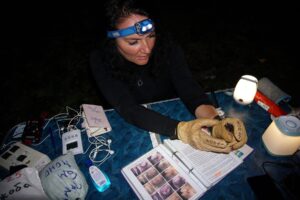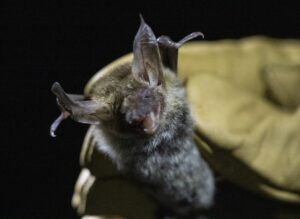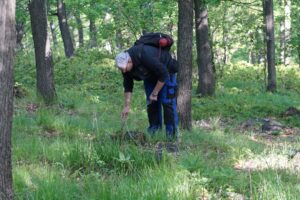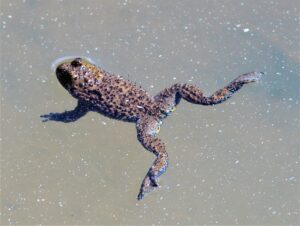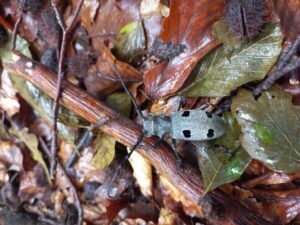Biodiversity monitoring is part of the measures for adaptation to climate change of one of the most vulnerable forests in our country – the artificial pine forests. The measures also include the carrying out thinning in Scots pine (Pinus sylvestris) forests, which are already largely affected by various natural disturbances. Many of these forests are artificially created in atypical locations and this, together with climate change, are among the main reasons why they are increasingly exposed to natural hazards. The thinning will also support the development of natural vegetation, which is more resistant to climate changes.
The present study involves the collection of information on high conservation value species of birds, insects and bats necessary for the purposes of the CLIMAFORCEELIFE project – project number: LIFE19 CCA/SK/001276.
The purpose of the study is monitoring of biodiversity in forests threatened by climate change. The monitoring is planned to last several years and includes the observation of various animal species, mainly birds, bats and insects. The forest sites where the field work is carried out are carefully selected by WWF and Southwest State Forest Enterprise (SWSFE) experts, according to specific criteria and taking into account factors such as climate, type and density of the forest, geographical location, etc.
Biodiversity in the selected sites will be studied, both in places where adaptation measures will be applied, and in forests where felling will not be implemented, and it is important to do this before and after the planned felling. This way, it will be established in a scientific way whether targeted human intervention has a positive or negative impact on the species of conservation importance in the forests.
Monitoring is carried out during the spring-summer season, when the animals are most active and can be easily observed. We used a transect method for both bird and insect monitoring. As in 2022, due to the cold spring, we started the monitoring of birds and insects in the month of May. In the monitoring of the insects, an expert – entomologist Assoc. Dr. Rostislav Bekchiev helped us. Among the target species, we found the Stag beetle (Lucanus cervus), Morimus asper, Carabus intricatus and the larva of the extremely rare and difficult to observe – Cucujus cinnaberinus.
Among the target bird species, we observed Eurasian Goshawk (Accipiter gentilis), Eurasian sparrowhawk (Accipiter nisus), Great Spotted Woodpecker (Dendrocopos major), Black Woodpecker (Dryocopus martius), Green Woodpecker (Picus viridis) and many widespread bird species such as Blackbird (Turdus merula), European robin (Erithacus rubecula), various types of tit, Common wood pigeon (Columba palumbus), Stock dove (Columba oenas), Common Cuckoo (Cuculus canorus), Eurasian blackcap (Sylvia atricapilla), Eurasian nuthatch (Sitta europaea), Eurasian treecreeper (Certhia familiaris), Common chiffchaff (Phylloscopus collybita) and others. Among the most interesting species we found was a Tawny owl (Strix aluco), which we couldn’t see, but we found its feathers and pellets.
In the first days of August, together with the Bat expert Elena Stoeva, we carried out the monitoring of the bats. It took place in an artificial Scots pine forest, in which the intended thinning had just been carried out, and a natural beech forest, which will serve as a reference and in which no felling will take place. They are located at about 1,000 m above sea level within the Southwestern State Forest Enterprise. After the accumulation of empirical material, the results in naturally developing forests and those managed by man will be compared, and expert analysis will show the best model to counteract the effects of the climate crisis.
The following bat survey methods were used in the current study:
– Trapping with nets – The nets have been used over rivers, on forest roads and clearings and other suitable habitats that are used by bats as flight corridors. When carrying out the activity, the conditions of the permits are respected in accordance with Art. 49, para. 1, item 1 of the Law on Biological Diversity and Ordinance No. 8 of 12.12.2003.
The species we caught in our nets are 4 – Western barbastelle (Barbastella barbastellus), Lesser noctule (Nyctalus leisleri), Bechstein’s night bat (Myotis bechsteinii) and Brown long-eared bat (Plecotus auritus).
– Recordings with a Bat detector – the so-called “point method” was chosen for the recordings. It was preferred to the transect method, which in detector recordings is not as reliable and leads to the omission of certain groups of bats that emit quieter or more directed sounds – Horseshoe bats and Long-eared bats (Rhinolophus, Plecotus).
Recordings were carried out at specific points selected in advance, after familiarization with the nature of the habitats and the field situation.
Through the Bat detectors, we detected the sounds of 15 species of bats and another 7 that could not be precisely determined. Of these, the most numerous are Savi’s pipistrelle (Hypsugo savii), Common pipistrelle (Pipistrellus pipistrellus) and Nyctalus spp.
During the monitoring, we accidentally found some amphibians – Fire salamander (Salamandra salamandra) and Yellow-bellied toad (Bombina variegata) which will also be included in the monitoring database.
In order to produce results from monitoring, it must be continuous and based on a large database. However, we dare say that the greatest variety of species of birds, insects and bats we found in the natural and old forests. We hope that at the end of the project in 2027, a large part of the artificial pine plantations in which we work will have acquired the character we are aiming for and we will be able to observe an increasing variety of species in them as well.


